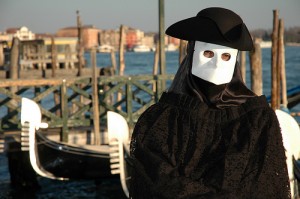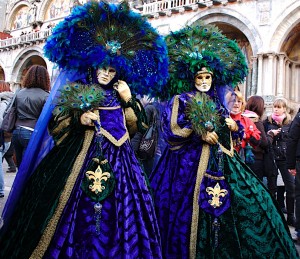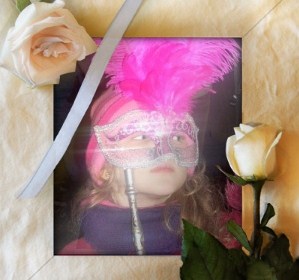The word carnival comes from the Latin “carnem levare” (“eliminate meat”) as originally indicated the banquet which was held on the last day of Carnival (Mardi Gras), immediately before the period of fasting and abstinence of Lent.
The first time it is mentioned the Carnival in Venice is in a document of 1094 by the Doge Vitale Falier.
Another document talks of the ancient Venice Carnival, which is made ”public holiday” in 1296. At that time the carnival lasted six weeks, from 26 December until Ash Wednesday (the Wednesday before the first Sunday of Lent).
 However, the carnival has much more ancient traditions that we recall, the ancestor worship of passing from winter to spring, cults present in almost all civilizations ; the Latin Saturnalia or the Dionysian cults in which the motto was “Semel in insanire year licet” (“once a year is not allowed to have brakes”)
However, the carnival has much more ancient traditions that we recall, the ancestor worship of passing from winter to spring, cults present in almost all civilizations ; the Latin Saturnalia or the Dionysian cults in which the motto was “Semel in insanire year licet” (“once a year is not allowed to have brakes”)
Studies on the carnival’s anthropology explain that between Epiphany and Lent “the world turned upside down: the child was disrespectful to his father, the sexes exchanged, was no longer forbidden to mock the powerful. Transgress the law meant,however, celebrate it. Violating the law only once, during the controlled party , equivalent to recognize his lordship over the rest of the year. It was part of the great illusion of the carnival in one place, unique in the world, where anything can happen, where every view continues to enchant.
 In the eighteenth century the Venetian Carnival reaches its peak and international recognition .The notorious protagonist of this era and his adventures in Venice,made him one of the most famous characters of the time: Giacomo Casanova.
In the eighteenth century the Venetian Carnival reaches its peak and international recognition .The notorious protagonist of this era and his adventures in Venice,made him one of the most famous characters of the time: Giacomo Casanova.
At that time the Venetians have opened numerous small theaters, aimed by an popular audience and many talented playwrights, representing increasingly sophisticated and complex works.
Venice was all part of a big stage in disguise, in which actors and audience merged in a unique and immense procession of shapes and colors, in a large open-air party: trumpets, fifes, drums, acrobats, jugglers, vendors street vendors, public dances where anyone could frolic in disguise as he wanted. The vendors were selling all kinds of merchandise, from seasonal fruits to rich fabrics, from spices to food from distant
countries, especially from the orient.
The most common masks were Harlequin, Brighella, pants or just a black cloak; the cloak, and on the face, the classic black mask; the Bauta, behind which the patricians and the ladies mingled with the people “to became mad of joy”.
 Bauta-a white mask under a black tricorn hat and dark coat complemented by a wraparound – widely used in theater.
Bauta-a white mask under a black tricorn hat and dark coat complemented by a wraparound – widely used in theater.
The greeting that sounded continually when you met a new “character” was simply: Hello mask.
The masks provide anonymity typical of Carnival, so music and dancing could be rampant, besides the fact that social differences disappear and you could safely take around the government and the noble, without fear of retaliation. It gave the illusion to the lower classes to become, for a short period of the year, similar to the powerful .
Obviously this is to give an outlet to the social tensions
Gnata- a mask with the likeness to a cat, accompanied by a basket on his arm that usually contained a kitten.
The days were more intense on Shrove Tuesday and Mardi Gras “giovedì grasso and martedì grasso”. A special attraction was, and still is, the Flight of the Dove, an acrobat who went down with the racing from the Campanile di San Marco to the Loggia of the Palazzo Ducale.
The show was not always the same: during the carnival 1680 “Sante from Ca ‘Lezze, managed to climb up to the belfry with a live horse, then climbed on top of “the angel ” where performed a thousand pirouettes”.
“During the following year carnival Sante went up with a small boat, pretending to row with true comedian mastery and come to the belfry climbed on the head of ” the angel” with tightrope games” .
Other attractions were the Strength of Hercules, where participants created human towers and the Machine fireworks.
But especially at night, wearing a disguise and with the complicity of the dark, it was easier to commit crimes of various kinds, such as muggings, robberies and harassment, without the slightest chance of being recognized.
 So as early as February 22, 1339 were introduced the decrees to limit: of circulate in mask for the city during the night, the entrance to the sacred places with mask ,to bring any item of a dangerous nature for the safety of others, or the prohibition of prostitution in mask.
So as early as February 22, 1339 were introduced the decrees to limit: of circulate in mask for the city during the night, the entrance to the sacred places with mask ,to bring any item of a dangerous nature for the safety of others, or the prohibition of prostitution in mask.
The Carnival of Venice was suspended in 1797 due to the Napoleonic occupation, although Burano and Murano, however,continued the festivities ,in a minor key.
 In 1979, after almost two centuries, the old tradition of Venice Carnival officially resources from its ashes, thanks to the initiative and efforts of several professional
In 1979, after almost two centuries, the old tradition of Venice Carnival officially resources from its ashes, thanks to the initiative and efforts of several professional
associations and to the citizens.Since then, each year is dedicated to a particular theme
other items:http://dipoco.altervista.org/articles/
visit my website http://ginocosta.altervista.org/you-can-do-it.html
On facebook : https://www.facebook.com/pages/Venezia/630678023668582?ref=profile
By : http://dipoco.altervista.org/